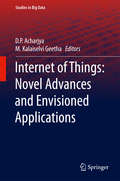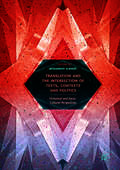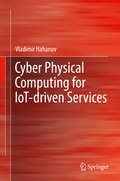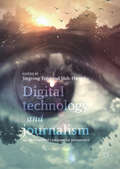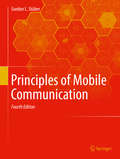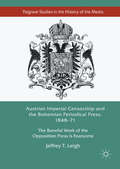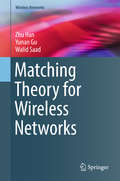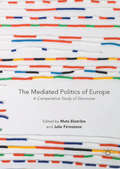- Table View
- List View
Contract Theory for Wireless Networks (Wireless Networks)
by Yanru Zhang Zhu HanThis book presents theoretical research between wireless communications, networking, and economics using the framework of contract theory. This work fills a void in the literature by closely combining contract theoretical approaches with wireless networks design problems. Topics covered include classification in contract theory, reward design, adverse selection, and moral hazard. The authors also explore incentive mechanisms for device-to-device communication in cellular networks, insurance plans for service assurance in cloud computing markets with incomplete information, multi-dimensional incentive mechanisms and tournament based incentive mechanisms in mobile crowdsourcing. Financial applications include financing contracts with adverse selection for spectrum trading in cognitive radio networks and complementary investment of infrastructure and service providers in wireless network visualization. This book offers a useful reference for engineers and researchers in the wireless communication community who seek to integrate the notions from contract theory and wireless engineering, while emphasizing on how contract theory can be applied in wireless networks. It is also suitable for advanced-level students studying information systems or communications engineering.
Internet of Things: Novel Advances and Envisioned Applications (Studies in Big Data #25)
by D. P. Acharjya M. Kalaiselvi GeethaThis book focuses on a combination of theoretical advances in the Internet of Things, cloud computing and its real-life applications to serve society. The book discusses technological innovations, authentication, mobility support and security, group rekeying schemes and a range of concrete applications. The Internet has restructured not only global interrelations, but also an unbelievable number of personal characteristics. Machines are increasingly able to control innumerable autonomous gadgets via the Internet, creating the Internet of Things, which facilitates intelligent communication between humans and things, and among things. The Internet of Things is an active area of current research, and technological advances have been supported by real-life applications to establish their soundness. The material in this book includes concepts, figures, graphs, and tables to guide researchers through the Internet of Things and its applications for society.
Translation and the Intersection of Texts, Contexts and Politics: Historical and Socio-Cultural Perspectives
by Mohammed AlbakryThis book analyzes the impact of historical, political and sociocultural contexts on the reading, rewriting and translating of texts. The authors base their arguments on their experiences of translating or researching different text types, taking in fiction, short stories, memoirs, religious texts, scientific treatises, and news reports from a variety of different languages and cultural traditions. In doing so they cover a wide range of contexts and time periods, including Early Modern Europe, post-1848 Switzerland, nineteenth-century Portugal, Egypt in the early twentieth century under British colonial rule, Spain under Franco’s dictatorship, and contemporary Peru and China. They also consider the theoretical and pedagogical implications of their conclusions for translation students and practitioners. This edited collection will be of great interest to scholars working in translation studies, applied linguistics, and on issues of cultural difference.
Translation and the Intersection of Texts, Contexts and Politics: Historical and Socio-Cultural Perspectives
by Mohammed AlbakryThis book analyzes the impact of historical, political and sociocultural contexts on the reading, rewriting and translating of texts. The authors base their arguments on their experiences of translating or researching different text types, taking in fiction, short stories, memoirs, religious texts, scientific treatises, and news reports from a variety of different languages and cultural traditions. In doing so they cover a wide range of contexts and time periods, including Early Modern Europe, post-1848 Switzerland, nineteenth-century Portugal, Egypt in the early twentieth century under British colonial rule, Spain under Franco’s dictatorship, and contemporary Peru and China. They also consider the theoretical and pedagogical implications of their conclusions for translation students and practitioners. This edited collection will be of great interest to scholars working in translation studies, applied linguistics, and on issues of cultural difference.
Cognitive Technologies (Telecommunications and Information Technology)
by Alberto Paradisi Fabrício Lira Figueiredo Rafael Carvalho Figueiredo Alan Godoy Souza MelloThis book focuses on the next generation optical networks as well as mobile communication technologies. The reader will find chapters on Cognitive Optical Network, 5G Cognitive Wireless, LTE, Data Analysis and Natural Language Processing. It also presents a comprehensive view of the enhancements and requirements foreseen for Machine Type Communication. Moreover, some data analysis techniques and Brazilian Portuguese natural language processing technologies are also described here.
Resource Management for Energy and Spectrum Harvesting Sensor Networks (SpringerBriefs in Electrical and Computer Engineering)
by Deyu Zhang Zhigang Chen Haibo Zhou Xuemin Sherman ShenThis SpringerBrief offers a comprehensive review and in-depth discussion of the current research on resource management. The authors explain how to best utilize harvested energy and temporally available licensed spectrum. Throughout the brief, the primary focus is energy and spectrum harvesting sensor networks (ESHNs) including energy harvesting (EH)-powered spectrum sensing and dynamic spectrum access.To efficiently collect data through the available licensed spectrum, this brief examines the joint management of energy and spectrum. An EH-powered spectrum sensing and management scheme for Heterogeneous Spectrum Harvesting Sensor Networks (HSHSNs) is presented in this brief. The scheme dynamically schedules the data sensing and spectrum access of sensors in ESHSNs to optimize the network utility, while considering the stochastic nature of EH process, PU activities and channel conditions.This brief also provides useful insights for the practical resource management scheme design for ESHSNs and motivates a new line of thinking for future sensor networking. Professionals, researchers, and advanced-level students in electrical or computer engineering will find the content valuable.
Guide to Big Data Applications (Studies in Big Data #26)
by S. SrinivasanThis handbook brings together a variety of approaches to the uses of big data in multiple fields, primarily science, medicine, and business. This single resource features contributions from researchers around the world from a variety of fields, where they share their findings and experience. This book is intended to help spur further innovation in big data. The research is presented in a way that allows readers, regardless of their field of study, to learn from how applications have proven successful and how similar applications could be used in their own field. Contributions stem from researchers in fields such as physics, biology, energy, healthcare, and business. The contributors also discuss important topics such as fraud detection, privacy implications, legal perspectives, and ethical handling of big data.
The Emerging WDM EPON
by Mirjana Radivojević Petar MatavuljThis book proposes dynamic wavelength and bandwidth allocation (DWBA), a hybrid of time-division multiplexing (TDM) and wavelength-division multiplexing (WDM), which offers a solution for service providers faced with multiservice networks. It discusses different models, architectures and implementations and evaluates their performance.
Potential-Based Analysis of Social, Communication, and Distributed Networks (Springer Theses)
by Seyed Rasoul EtesamiThis work makes major contributions to the thriving area of social, communication, and distributed networks by introducing novel methodologies and tools toward the study of the evolutionary behaviors of these networks, as well as their computational complexity and rates of convergence. By departing from the classical approaches and results in the literature, this work shows that it is possible to handle more complex and realistic nonlinear models where either the traditional approaches fail or lead to weak results. The author also develops several easily implementable algorithms, delivering excellent performance guarantees while running faster than those that exist in the literature. The study undertaken and the approaches adopted enable the analysis of the evolution of several different types of social and distributed networks, with the potential to apply to and resolve several other outstanding issues in such networks.
Crowd-Powered Mobile Computing and Smart Things (SpringerBriefs in Computer Science)
by Seng W. LokeThis SpringerBrief provides a synergistic overview of technology trends by emphasizing five linked perspectives: crowd+cloud machines, extreme cooperation with smart things, scalable context-awareness, drone services for mobile crowds and social links in mobile crowds. The authors also highlight issues and challenges at the intersection of these trends. Topics covered include cloud computing, Internet of Things, mobile and wearable computing, crowd computing, the culture of thing sharing, collective computing, and swarm dynamics. The brief is a useful resource and a starting point for researchers, students or anyone interested in the contemporary computing landscape.
Cloud Mobile Networks: From RAN to EPC (Wireless Networks)
by Mojtaba Vaezi Ying ZhangThis book explores the challenges and opportunities in exploiting cloud technologies for 5G, ranging from radio access network (RAN) to the evolved packet core (EPC). With a specific focus on cloud RAN and EPC, the text carefully explains the influence of recent network technologies such as software defined networking (SDN), visualization, and cloud technologies in the evolution of architecture for future mobile networks. The book discusses the causes, benefits and challenges of cloud RAN and its interplay with other evolving technologies for future mobile networks.Researchers and professionals involved in mobile technology or cloud computing will find this book a valuable resource. The text is also suitable for advanced-level students studying all types of networking.
Performance Evaluation for Network Services, Systems and Protocols
by Stênio FernandesThis book provides a comprehensive view of the methods and approaches for performance evaluation of computer networks. It offers a clear and logical introduction to the topic, covering both fundamental concepts and practical aspects. It enables the reader to answer a series of questions regarding performance evaluation in modern computer networking scenarios, such as ‘What, where, and when to measure?’, ‘Which time scale is more appropriate for a particular measurement and analysis?’, 'Experimentation, simulation or emulation? Why?’, and ‘How do I best design a sound performance evaluation plan?’. The book includes concrete examples and applications in the important aspects of experimentation, simulation and emulation, and analytical modeling, with strong support from the scientific literature. It enables the identification of common shortcomings and highlights where students, researchers, and engineers should focus to conduct sound performance evaluation. This book is a useful guide to advanced undergraduates and graduate students, network engineers, and researchers who plan and design proper performance evaluation of computer networks and services. Previous knowledge of computer networks concepts, mechanisms, and protocols is assumed. Although the book provides a quick review on applied statistics in computer networking, familiarity with basic statistics is an asset. It is suitable for advanced courses on computer networking as well as for more specific courses as a secondary textbook.
Guide to Cisco Routers Configuration: Becoming a Router Geek (SpringerBriefs in Computer Science)
by Mohammed M. AlaniThis easy-to-follow text/reference presents a practical guide to the configuration of Cisco routers, from tasks for beginners to advanced operations. The work starts with the simple step-by-step task of connecting the router and performing basic configuration, before building up to complex and sensitive operations such as router IOS upgrade and Site-to-Site VPNs. This updated and expanded new edition has been enhanced with a more detailed treatment of each topic, supported by a set of training scenarios. Features: discusses basic configuration, domestic duties, standard and advanced routing, WAN technologies, security, router management, remote connectivity, and practical tips; explains in detail the steps required to configure different protocols on Cisco routers; includes coverage of MPLS, multicasting, GRE, HSRP, reflexive and timed-access lists, and configuration steps for IPv6 (NEW); provides an extensive selection of training scenarios, designed to offer hands-on practice in the relevant tasks (NEW).
Cyber Physical Computing for IoT-driven Services
by Vladimir HahanovThis book presents the cyber culture of micro, macro, cosmological, and virtual computing. The book shows how these work to formulate, explain, and predict the current processes and phenomena monitoring and controlling technology in the physical and virtual space.The authors posit a basic proposal to transform description of the function truth table and structure adjacency matrix to a qubit vector that focuses on memory-driven computing based on logic parallel operations performance. The authors offer a metric for the measurement of processes and phenomena in a cyberspace, and also the architecture of logic associative computing for decision-making and big data analysis.The book outlines an innovative theory and practice of design, test, simulation, and diagnosis of digital systems based on the use of a qubit coverage-vector to describe the functional components and structures. Authors provide a description of the technology for SoC HDL-model diagnosis, based on Test Assertion Blocks Activated Graph. Examples of cyber-physical systems for digital monitoring and cloud management of social objects and transport are proposed. A presented automaton model of cosmological computing explains the cyclical and harmonious evolution of matter-energy essence, and also a space-time form of the Universe.
Information Technology - New Generations: 14th International Conference on Information Technology (Advances in Intelligent Systems and Computing #558)
by Shahram LatifiThis volume presents a collection of peer-reviewed, scientific articles from the 14th International Conference on Information Technology – New Generations, held at the University of Nevada at Las Vegas on April 10–12, at Tuscany Suites Hotel in Las Vegas. The Book of Chapters addresses critical areas of information technology including web technology, communications, computing architectures, software engineering, security, and data mining.
Digital Technology and Journalism: An International Comparative Perspective
by Jingrong Tong Shih-Hung LoThis edited volume discusses the theoretical, practical and methodological issues surrounding changes in journalism in the digital era. The chapters explore how technological innovations have transformed journalism and how an international comparative perspective can contribute to our understanding of the topic. Journalism is examined within Anglo-American and European contexts as well as in Asia and Africa, and comparative approaches and methods for journalism studies in the digital age are evaluated. In so doing, the book offers a thorough investigation of changes in journalistic norms, practices and genres in addition to providing an international and comparative perspective for understanding these changes and what they mean to journalism. Written by both leading scholars and media practitioners in the field, the articles in this collection are based on theoretical frameworks and empirical data, drawn from content analysis of newspaper and online coverage, in-depth interviews with news practitioners, observation on the websites of news organisations and analysis of journalists on Twitter. The result is a cohesive compilation that offers the reader an up-to-date and comprehensive understanding of digital developments in journalism and comparative journalism studies.
Digital Technology and Journalism: An International Comparative Perspective
by Jingrong Tong Shih-Hung LoThis edited volume discusses the theoretical, practical and methodological issues surrounding changes in journalism in the digital era. The chapters explore how technological innovations have transformed journalism and how an international comparative perspective can contribute to our understanding of the topic. Journalism is examined within Anglo-American and European contexts as well as in Asia and Africa, and comparative approaches and methods for journalism studies in the digital age are evaluated. In so doing, the book offers a thorough investigation of changes in journalistic norms, practices and genres in addition to providing an international and comparative perspective for understanding these changes and what they mean to journalism. Written by both leading scholars and media practitioners in the field, the articles in this collection are based on theoretical frameworks and empirical data, drawn from content analysis of newspaper and online coverage, in-depth interviews with news practitioners, observation on the websites of news organisations and analysis of journalists on Twitter. The result is a cohesive compilation that offers the reader an up-to-date and comprehensive understanding of digital developments in journalism and comparative journalism studies.
Principles of Mobile Communication
by Gordon L. StüberThis mathematically rigorous overview of physical layer wireless communications is now in a 4th, fully revised and updated edition. The new edition features new content on 4G cellular systems, 5G cellular outlook, bandpass signals and systems, and polarization, among many other topics, in addition to a new chapters on channel assignment techniques. Along with coverage of fundamentals and basic principles sufficient for novice students, the volume includes finer details that satisfy the requirements of graduate students aiming to conduct in-depth research. The book begins with a survey of the field, introducing issues relevant to wireless communications. The book moves on to cover relevant discrete subjects, from radio propagation, to error probability performance, and cellular radio resource management. An appendix provides a tutorial on probability and random processes. The content stresses core principles that are applicable to a broad range of wireless standards. New examples are provided throughout the book to better explain the more complex material to the reader. Additional problems have also been added to those already appearing at the ends of the chapters to make the book more suitable for course instruction.
Austrian Imperial Censorship and the Bohemian Periodical Press, 1848–71: The Baneful Work of the Opposition Press is Fearsome
by Jeffrey T. LeighThis book analyzes the conduct of press policy in Bohemia from the Revolutions of 1848 through the period of the Tábory, 1867-71. In the aftermath of the revolutions, the Habsburg state, far from constituting an historical relic, proved itself boldly innovative, inaugurating liberal reforms, most importantly the rule of law. While the reforms helped it to survive its immediate challenges, they nonetheless, quite paradoxically, created an environment in which the periodical press continued to advance perspectives emblematic of the revolution, even during the era of Neoabsolutism. This new legal environment fostered the rise of the bourgeois public sphere, as theorized by Jürgen Habermas, and the very political movements that would contribute to its demise, as signaled in the Tábory campaign of 1867-71. At the nexus of civil society and the state stood the provincial Habsburg officials responsible for public order and security. Their experience was one of endeavoring to balance the ideals of the rule of law imposed by the Imperial center and their own vital concerns regarding the survival of the Monarchy. This work, for the first time, concentrates on the role of these officials who determined what would—and would not—appear in print.
Austrian Imperial Censorship and the Bohemian Periodical Press, 1848–71: The Baneful Work of the Opposition Press is Fearsome
by Jeffrey T. LeighThis book analyzes the conduct of press policy in Bohemia from the Revolutions of 1848 through the period of the Tábory, 1867-71. In the aftermath of the revolutions, the Habsburg state, far from constituting an historical relic, proved itself boldly innovative, inaugurating liberal reforms, most importantly the rule of law. While the reforms helped it to survive its immediate challenges, they nonetheless, quite paradoxically, created an environment in which the periodical press continued to advance perspectives emblematic of the revolution, even during the era of Neoabsolutism. This new legal environment fostered the rise of the bourgeois public sphere, as theorized by Jürgen Habermas, and the very political movements that would contribute to its demise, as signaled in the Tábory campaign of 1867-71. At the nexus of civil society and the state stood the provincial Habsburg officials responsible for public order and security. Their experience was one of endeavoring to balance the ideals of the rule of law imposed by the Imperial center and their own vital concerns regarding the survival of the Monarchy. This work, for the first time, concentrates on the role of these officials who determined what would—and would not—appear in print.
Heterogeneous Information Network Analysis and Applications (Data Analytics)
by Chuan Shi Philip S. YuThis book offers researchers an understanding of the fundamental issues and a good starting point to work on this rapidly expanding field. It provides a comprehensive survey of current developments of heterogeneous information network. It also presents the newest research in applications of heterogeneous information networks to similarity search, ranking, clustering, recommendation. This information will help researchers to understand how to analyze networked data with heterogeneous information networks. Common data mining tasks are explored, including similarity search, ranking, and recommendation. The book illustrates some prototypes which analyze networked data.Professionals and academics working in data analytics, networks, machine learning, and data mining will find this content valuable. It is also suitable for advanced-level students in computer science who are interested in networking or pattern recognition.
Matching Theory for Wireless Networks (Wireless Networks)
by Zhu Han Yunan Gu Walid SaadThis book provides the fundamental knowledge of the classical matching theory problems. It builds up the bridge between the matching theory and the 5G wireless communication resource allocation problems. The potentials and challenges of implementing the semi-distributive matching theory framework into the wireless resource allocations are analyzed both theoretically and through implementation examples. Academics, researchers, engineers, and so on, who are interested in efficient distributive wireless resource allocation solutions, will find this book to be an exceptional resource.
The Mediated Politics of Europe: A Comparative Study of Discourse
by Mats Ekström Julie FirmstoneThis edited collection makes a unique contribution to analyses of the changing nature and challenges of mediated political communication, through a distinctive comparative discourse analytical approach. The book explores how politics is performed and discursively constructed in television news and current affairs in five countries (France, Greece, Italy, Sweden and the UK) and focuses on a moment in time in European politics characterized by challenging tensions; increased Euroscepticism, questioning of mainstream politics; accentuated gaps between the elite and the citizens, and polarizations between member states. Emphasising the performative and discursive dimensions of political communication, the chapters provide a detailed comparative analysis that is centred around three themes: how symbolic representations of politics are shaped by journalistic practices, genres and styles of news reporting; the language and performances of mainstream and populist political leaders; and the participation and representation of citizens’ voices.
The Mediated Politics of Europe: A Comparative Study of Discourse
by Mats Ekström Julie FirmstoneThis edited collection makes a unique contribution to analyses of the changing nature and challenges of mediated political communication, through a distinctive comparative discourse analytical approach. The book explores how politics is performed and discursively constructed in television news and current affairs in five countries (France, Greece, Italy, Sweden and the UK) and focuses on a moment in time in European politics characterized by challenging tensions; increased Euroscepticism, questioning of mainstream politics; accentuated gaps between the elite and the citizens, and polarizations between member states. Emphasising the performative and discursive dimensions of political communication, the chapters provide a detailed comparative analysis that is centred around three themes: how symbolic representations of politics are shaped by journalistic practices, genres and styles of news reporting; the language and performances of mainstream and populist political leaders; and the participation and representation of citizens’ voices.
Media, Diaspora and Conflict
by Ola OgunyemiThis edited collection argues that the connective and orientation roles ascribed to diasporic media overlook the wider roles they perform in reporting intractable conflicts in the Homeland. Considering the impacts of conflict on migration in the past decades, it is important to understand the capacity of diasporic media to escalate or deescalate conflicts and to serve as a source of information for their audiences in a competitive and fragmented media landscape. Using an interdisciplinary perspective, the chapters examine how the diasporic media projects the constructive and destructive outcomes of conflicts to their particularistic audiences within the global public sphere. The result is a volume that makes an important contribution to scholarship by offering critical engagements and analyzing how the diasporic media communicates information and facilitates dialogue between conflicting parties, while adding to new avenues of empirical case studies and theory development in comprehending the media coverage of conflict.

